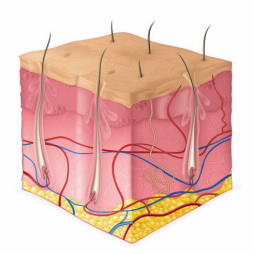FOR IMMEDIATE RELEASE | May 09, 2011
The skinny on how shed skin reduces indoor air pollution
Note to journalists: Please credit the journal or the American Chemical Society as publisher of this report.
WASHINGTON, May 9, 2011 — Flakes of skin that people shed at the rate of 500 million cells every day are not just a nuisance — the source of dandruff, for instance, and a major contributor to house dust. They actually can be beneficial. A new study, published in the American Chemical Society’s journal, Environmental Science & Technology, concludes that oil in those skin cells makes a small contribution to reducing indoor air pollution.
Charles Weschler and colleagues explain that humans shed their entire outer layer of skin every 2-4 weeks at the rate of 0.001 – 0.003 ounces of skin flakes every hour. Those flakes contain skin oils, including cholesterol and “squalene,” and are a major constituent of the dust that accumulates on tables and other surfaces in homes and offices. Past research suggested that squalene from passengers’ skin had a role in reducing levels of ozone — a pollutant that can irritate the eyes, nose and throat and worsen asthma symptoms — from the air in airplane cabins.
Media Contact
Michael Bernstein
202-872-6042
m_bernstein@acs.org
Michael Woods
202-872-6293
m_woods@acs.org
“It is only within the last five years that we’ve grown to appreciate the central role that squalene (from human skin oil) plays in oxidation chemistry within indoor environments,” the report notes. “More than half of the ozone removal measured in a simulated aircraft cabin was found to be a consequence of ozone reacting with exposed, skin, hair, and clothing of passengers.”
In the new study, the scientists set out to make the first extensive determinations of cholesterol and squalene in dust in homes and daycare centers and to figure out how these substances affect indoor air pollution. The scientists analyzed dust samples collected from 500 bedrooms of children aged 3-5 and the 151 daycare centers the children attended in the city of Odense, Denmark and its surroundings as part of the Danish Indoor Environment and Children’s Health Study.
Among their findings: “Squalene in settled dust … contributes, in a small way, to the indoor removal of ozone,” reducing indoor ozone levels roughly 2 to 15 percent.
The authors acknowledge funding from the Villum Foundation and FORMAS.
JOURNALISTS’ LINK FOR FULL TEXT of
“Squalene and Cholesterol in Dust from Danish Homes and Daycare Centers”
CONTACT:
Charles J. Weschler, Ph.D.
University of Medicine and Dentistry of New Jersey and Rutgers University
Piscataway, N.J. 08854
and
Technical University of Denmark
DK-2800 Lyngby, Denmark
Phone: +1-732-235-4114
Fax: +1-732-235-4569
E-mail: weschlch@umdnj.edu
###

can help reduce indoor air pollution.


